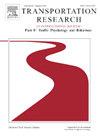Decoding the silent dialogue: Unveiling driver-pedestrian communication dynamics with a hidden Markov model
IF 3.5
2区 工程技术
Q1 PSYCHOLOGY, APPLIED
Transportation Research Part F-Traffic Psychology and Behaviour
Pub Date : 2025-02-01
DOI:10.1016/j.trf.2025.01.011
引用次数: 0
Abstract
Motivation
To enable vehicle automation to negotiate in a mixed traffic environment there is a need for formal methods that describe the communication process between drivers and pedestrians.
Aim
This work aims to model the underlying states of communication that a dyad of a pedestrian-driver system experiences when a pedestrian crosses the road in front of an approaching vehicle.
Method
We analyzed a naturalistic driving dataset comprised of 328 encounters which were identified using a forward-facing camera from 61 drivers. A Hidden Markov Model (HMM) was employed to model the underlying communication states in these encounters. The model accounted for observable behaviors, including vehicle and pedestrian movement, pedestrian and driver gaze, and instances of driver waving, capturing the dynamic interplay between both parties.
Results
The HMM revealed six distinct communication states: four representing unidirectional communication, where the driver either braked or accelerated/cruised while looking toward or away from the pedestrian and two bidirectional communication states including signs of negotiation, where drivers and pedestrians were likely to look in the direction of one another and pedestrians were likely to pause, with or without vehicle movement. Notably, bidirectional communication occurred in approximately 60% of the encounters, typically early on, but diminished as the encounter progressed. In contrast, unidirectional communication involving an accelerating/cruising vehicle became more frequent toward the end of the encounters.
Conclusion
This study introduces a novel model for analyzing pedestrian-driver encounters, highlighting the importance of bidirectional communication in the early stages of interactions. The findings suggest that not all encounters involve reciprocal communication and that communication patterns shift over time. Future work can build on this model to identify instances of communication breakdowns and explore potential strategies for mitigating them.
求助全文
约1分钟内获得全文
求助全文
来源期刊
CiteScore
7.60
自引率
14.60%
发文量
239
审稿时长
71 days
期刊介绍:
Transportation Research Part F: Traffic Psychology and Behaviour focuses on the behavioural and psychological aspects of traffic and transport. The aim of the journal is to enhance theory development, improve the quality of empirical studies and to stimulate the application of research findings in practice. TRF provides a focus and a means of communication for the considerable amount of research activities that are now being carried out in this field. The journal provides a forum for transportation researchers, psychologists, ergonomists, engineers and policy-makers with an interest in traffic and transport psychology.

 求助内容:
求助内容: 应助结果提醒方式:
应助结果提醒方式:


